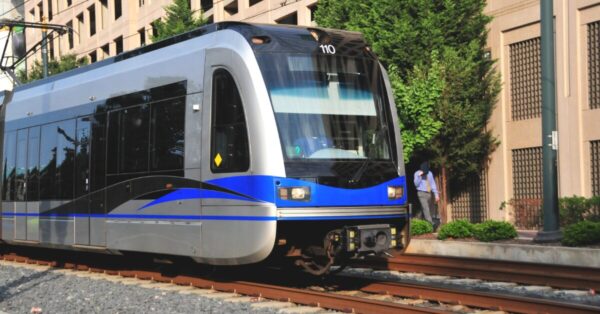Iryna’s Death: What We’ve Said, What’s Being Done, and Why the November 4 Vote Matters More Than Ever

On August 22, 2025, our city was shaken by a tragic and senseless loss. Iryna Zarutska, a 23-year-old Ukrainian refugee, was fatally attacked while riding the LYNX Blue Line near the East/West Station in South End. Her death marked the first fatal attack onboard the Blue Line since it opened in 2007.
What Sustain Charlotte Has Done
On September 3, 2025, we issued a public statement in response to Iryna’s death. In that statement, we shared examples of safety measures other cities have put in place, including:
- Uniformed but unarmed safety ambassadors who walk platforms, ride trains, or circulate in stations.
- They provide a sense of oversight, answer questions, and serve as trained eyes/ears for emergencies.
- Cameras in stations and on vehicles that are both functional and clearly marked with signage.
- Well-placed monitors or public notices that remind riders the system is monitored.
- Real-time info screens and emergency call buttons (and signage showing where they are).
- Quick response acknowledgment when a call button is pressed or a report is made.
And we emphasized that mental illness often plays a central role in tragedies like this, and that strengthening support systems is one of the most effective long-term strategies for preventing violence.
This week, we sent a letter to the Charlotte City Council and the Metropolitan Transit Commission (MTC), building on that statement, and urging leaders to take additional action. Read our letter here.
In it, we emphasized:
- The urgency of public safety, while making clear that CATS is being unfairly blamed for a tragedy rooted in untreated mental illness and homelessness.
- Expert perspectives — including Todd Litman of the Victoria Transport Policy Institute and Anastasia Loukaitou-Sideris of UCLA — that underscore the limits of relying on security-only solutions.
- That violent incidents like this are not unique to transit systems and cannot always be predicted or prevented by more officers alone.
- The need to reframe the solution: preventing future tragedies requires strengthening mental health services and housing supports, not just doubling down on transit security.
What the City Is Already Doing
We recognize and support the steps CATS has taken in recent weeks, which were presented to the Metropolitan Transit Commission this Wednesday. These include both measures already in place and new improvements scheduled for the coming weeks:
Initial security improvements (already underway):
- Deployment of PSS officers to fully staff the Blue Line.
- Addition of off-duty CMPD officers to supplement CATS security contractors (roughly 20 officers providing 800 hours of support per week).
- Officers integrated into existing security team schedules to strengthen coverage.
- Focused fare blitzes at Blue Line stations.
- New public address announcements, including “See Tracks, Think Trains” messages during National Rail Safety Week.
- Community engagement activities along the Blue Line to build visibility and awareness.
Upcoming security improvements:
- Launch of bike patrols along the Rail Trail (week of September 26).
- Deployment of UTVs for hard-to-access areas.
- Upgrade of ELERTS to the new PROTECT version, enhancing surveillance capabilities.
- Increased customer notification tools to keep riders informed.
- Establishment of a fare zone at the Charlotte Transportation Center (CTC) by late fall, limiting platform access to valid pass holders.
These steps demonstrate that CATS leadership are acting quickly and responsibly to address safety concerns. But while they are important, we must also acknowledge that these alone cannot prevent tragedies like Iryna’s.
What More Needs to Happen
Transit safety experts and our team at Sustain Charlotte believe a holistic, multi-pronged approach is required:
- Mental health and social service supports: Preventing violence long-term requires care for people experiencing homelessness, addiction, or untreated mental illness. (These can not be funded by the sales tax, but they are essential parts of the larger solution.)
- Frequent, reliable, and accessible transit service: More riders mean more natural oversight, safer conditions, and stronger communities on transit. (Can be funded by sales tax.)
- Infrastructure improvements: Safer station design, lighting, and pedestrian and bike connections that make the trip to and from transit secure. (Can be funded by sales tax.)
- Clear accountability: Safety measures must come with transparent goals, timelines, and oversight. (Can be funded by sales tax.)
Why Voting YES on the Sales Tax on November 4 Is Critical
The sales tax cannot be used to fund housing or health services. But it can fund the transportation improvements that are also critical to rider safety and community wellbeing.
Just as importantly, the sales tax is critical to sustaining the new security measures that CATS has already taken and those planned for the coming months as outlined above.
It’s also essential for increasing the frequency and reliability of trains and buses, safer station design and infrastructure, and clear accountability for safety improvements.
These steps all come with significant ongoing costs, and the referendum is the key to ensuring they can be fully implemented and maintained over time.
This is how we make transit not only a viable choice, but a safe and welcoming one.
Honoring Iryna
Iryna’s death was rare, but devastating. Honoring her means refusing to settle for surface-level fixes. We support the City’s immediate and planned steps, but true long-term safety requires deeper change — in how our community addresses homelessness, how we respond to mental illness, and how we invest in transit itself.
On November 4, we have an opportunity to take a big step in the right direction. By voting yes on the sales tax, we can build a safer, more reliable, and more equitable transportation system for everyone.
Thanks for reading!
As a nonprofit, community support is essential for us to keep doing what we do — including providing free articles like this. If you found this article helpful, please consider supporting Sustain Charlotte.
Want to stay in the loop? Subscribe to our weekly newsletter and follow us on Instagram and Facebook.
